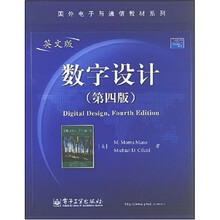1.Digital Systems and Binary Numbers.
1.1 Digital Systems
1.2 Binary Numbers
1.3 Number-Base Conversions
1.4 Octal and Hexadecimal Numbers
1.5 Complements
1.6 Signed Binary Numbers
1.7 Binary Codes
1.8 Binary Storage and Registers
1.9 Binary Logic
2 Boolean Algebra and Logic Gates
2.1 Introductiontlon
2.2 Basic Definitions
2.3 Axiomatic Definition of Boolean Algebra
2.4 Basic Theorems and Properties of Boolean Alqebra
2.5 Boolean Functions
2.6 Canonical and Standard Forms
2.7 0ther LogiC 0perations
2.8 DiqitaI Loqic Gates
2.9 Inteqrated Circuits
3.Gate-Level Minimization
3.1 Introduction
3.2 The Map Method
3.3 Four.Variable Map
3.4 Five.Variable Map
3.5 Product..0f..Sums Simplification
3.6 Don’t-Care Conditions
3.7 NAND and NOR Implementation
3.8 Other Tw0—Level Implementations
3.9 Exclusive.OR Function
3.10 Hardware Description Language
4.Combinational Logical
4.1 Introduction
4.2 Combinational Circuits
4.3 Analysis Procedure
4.4 Design Procedure
4.5 Binary Adder.Subtractor
4.6 Decimal Adder
4.7 Binary Multiplier
4.8 Maqnitude Comparator
4.9 Decoders
4.10 Encoders
4.11 Multiplexers
4.12 HDL Models of Combinational Circuits
5.Synchronous Sequential Logic
5.1 IntrOduction
5.2 Sequential Circuits
5.3 Storage Elements:Latches
5.4 Storage Elements:Flip·Flops
5.5 Analysis of Clocked Sequential Circuits
5.6 Synthesizable HDL Models of SequentiaCircuits
5.7 State Reduction and Assignment
5.8 Design Procedure
6.Registers and Counters
6.1 Registers
6.2 Shift Registers
……
7.Memory and Programmable Logic
8.Design at the Register Transfer Level
9.Asynchronous Sequential Logic
10.Digital Integrated Circuits
11.Laboratory Experiments with Standard ICs and FPGAs
12.Standard Graphic Symbols
13.Answers to Selected Problems
Index

 缺书网
缺书网 扫码进群
扫码进群





